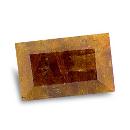|
|
||||||||||||||||
|
||||||||||||||||
|
||||||
|
|
|
|
Xenotime-(Y)
|
|
| | |
| Discovered in 1824; IMA status: Valid (pre-IMA; Grandfathered) | ||
|
| ||
|
Chemistry |
|
|
| |
|
YPO4 + REE | |
|
|
Yttrium Phosphate + traces of rare earth elements (REE) |
|
Molecular Weight: |
183.88 gm |
|
Composition: |
Yttrium |
48.35 % |
Y |
61.40 % |
Y2O3 |
|
|
Phosphorus |
16.84 % |
P |
38.60 % |
P2O5 |
|
|
Oxygen |
34.80 % |
O |
|
|
|
|
|
100.00 % |
|
100.00 % |
= TOTAL OXIDE |
|
|
|
||||
|
Classification |
|
|
| |
|
Phosphates | |
|
7/A.14-10 | |
|
|
8 : PHOSPHATES, ARSENATES, VANADATES
|
|
Related to: |
Xenotime Group. Chernovite-(Y)-Xenotime-(Y) Series. Isostructural with Zircon. |
|
Members of Group: |
Xenotime Group: Chernovite-(Y), Pretulite, Wakefieldite-(Ce), Wakefieldite-(La), Wakefieldite-(Nd), Wakefieldite-(Y), Xenotime-(Yb) |
|
Varieties: |
Chrysanthemum Stone (of Kimura) |
|
Synonyms: |
Castelnaudite, Hussakite, Phosphate of Yttria, Phosphyttrie, Tankelite, Tankite (of Haidinger) |
|
|
|
|
Crystal Data |
|
|
|
|
|
Short to long [001] prismatic crystals, with {010}, {110}, may be pyramidal {011}, equant, several other minor forms noted, to 5 cm. In radial or rosettelike aggregates of coarse crystals. |
|
|
On {111}, rare |
|
|
|
|
|
Physical Properties |
|
|
|
|
|
Good on {100} |
|
|
Irregular/uneven to splintery |
|
|
Brittle |
|
|
4.0 - 5.0 |
|
|
4.40 - 5.10 (g/cm3) |
|
|
May exhibit yellow cathodoluminescence. |
|
|
Not Radioactive |
|
|
Other: | |
|
|
|
|
Optical Properties |
|
|
|
|
|
Yellowish brown, reddish brown, flesh-red, grayish white, wine-yellow, pale yellow, greenish; in transmitted light, colorless to very pale yellowish green, yellow, or yellowish brown |
|
|
Translucent to opaque |
|
|
Vitreous to resinous |
|
|
1.720 - 1.827 Uniaxial ( + ) |
|
|
0.095 - 0.096 |
|
|
n/a |
|
|
Weak, dichroic; O = pink, yellow, or yellowish brown; E = brownish yellow, grayish brown, greenish |
|
|
|
|
|
Occurances |
|
|
|
|
|
Geological Setting: |
An accessory mineral in alkalic to granitic rocks, well-developed in associated pegmatites; in gneiss and Alpine veins; a common detrital mineral in placers. |
|
Common Associations: |
Zircon, Monazite, Rutile, Anatase, Brookite, Hematite, Ilmenite, Gadolinite, Allanite, Apatite, Yttrotantalite, Thorite |
|
Common Impurities: |
May contain minor REE, Ca, U, Th, Si, F and other elements. |
|
Type Locality: |
Hidra (Hitterø), Flekkefjord, Vest-Agder, Norway |
|
Year Discovered: |
1824 |
|
View mineral photos: | |
|
|
|
|
Unusual Gem Categories |
|
|
|
|
|
| |
|
|
|
|
More Information |
|
|
|
|
|
| |
|
|
|
|
Xenotime is unusual in that it is a paramagnetic mineral. Paramagnetism is a form of magnetism where certain minerals are attracted by an externally applied magnetic field, and form internal, induced magnetic fields in the direction of the applied magnetic field. In contrast with this behavior, diamagnetic minerals, such as Barite and Ludlamite are repelled by magnetic fields and form induced magnetic fields in the direction opposite to that of the applied magnetic field. Xenotime is named from the Greek words kenos (κευός) meaning vain and time (τιμή) meaning honor, more accurately translating to "vain glory". It was so named by French mineralogist François Sulpice Beudant as a rebuke of another scientist, Swedish chemist Jöns Jacob Berzelius, who claimed to have discovered a new chemical element in Xenotime which was later found to be the previously discovered yttrium. Xenotime was originally spelled "Kenotime" from the Greek word kenos, but over time "kenotime" was misread and misprinted as "xenotime". Although Xenotime is found in many localities throughout the world, gem quality crystals are very rare. Xenotime gems are usually a translucent yellowish brown to reddish brown with vitreous to resinous luster and a Moh's hardness of 4-5. Xenotime
distribution: numerous localities but fine crystals
are unusual. In Norway, from Lindesnes; on Hidra (Hitterö)
Island; around Tvedestrand and Arendal; at Raade, near
Moss; and elsewhere. From Ytterby, on Resarö Island,
near Vaxholm, Sweden. In Switzerland, from the Binntal,
Valais; in the Maderanertal, Uri; in the Tavetsch, Graubünden;
and many other places. Large crystals from the Yazgulem
Ridge, western Pamir Mountains, Tajikistan. At Sahamandrevo,
near Ampangabe, Madagascar. In the Ishikawa district,
Fukushima Prefecture, Japan. In Brazil, from Ataleia
and Ibitiara, Minas Gerais; at Brumado and Novo Horizonte,
Bahia. In the USA, in North Carolina, from placers in
Polk, McDowell, and Burke Counties; on Cheyenne Mountain,
El Paso County, and elsewhere in Colorado. In the Gunter
quarry, near McKenzie Lake, Ontario, Canada. |
|
|
We
have not photographed our Xenotime gems yet. Please
check back soon. |
